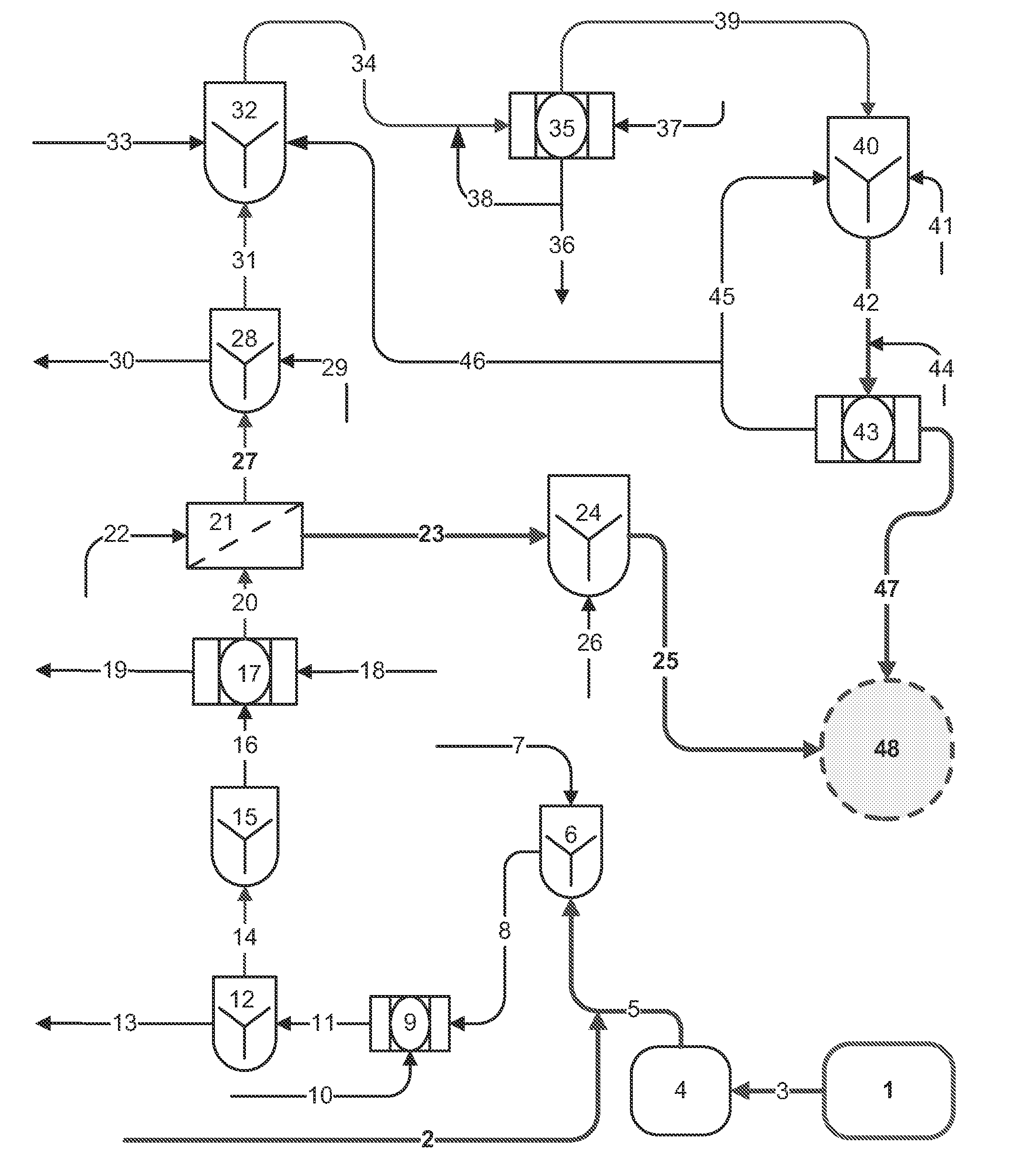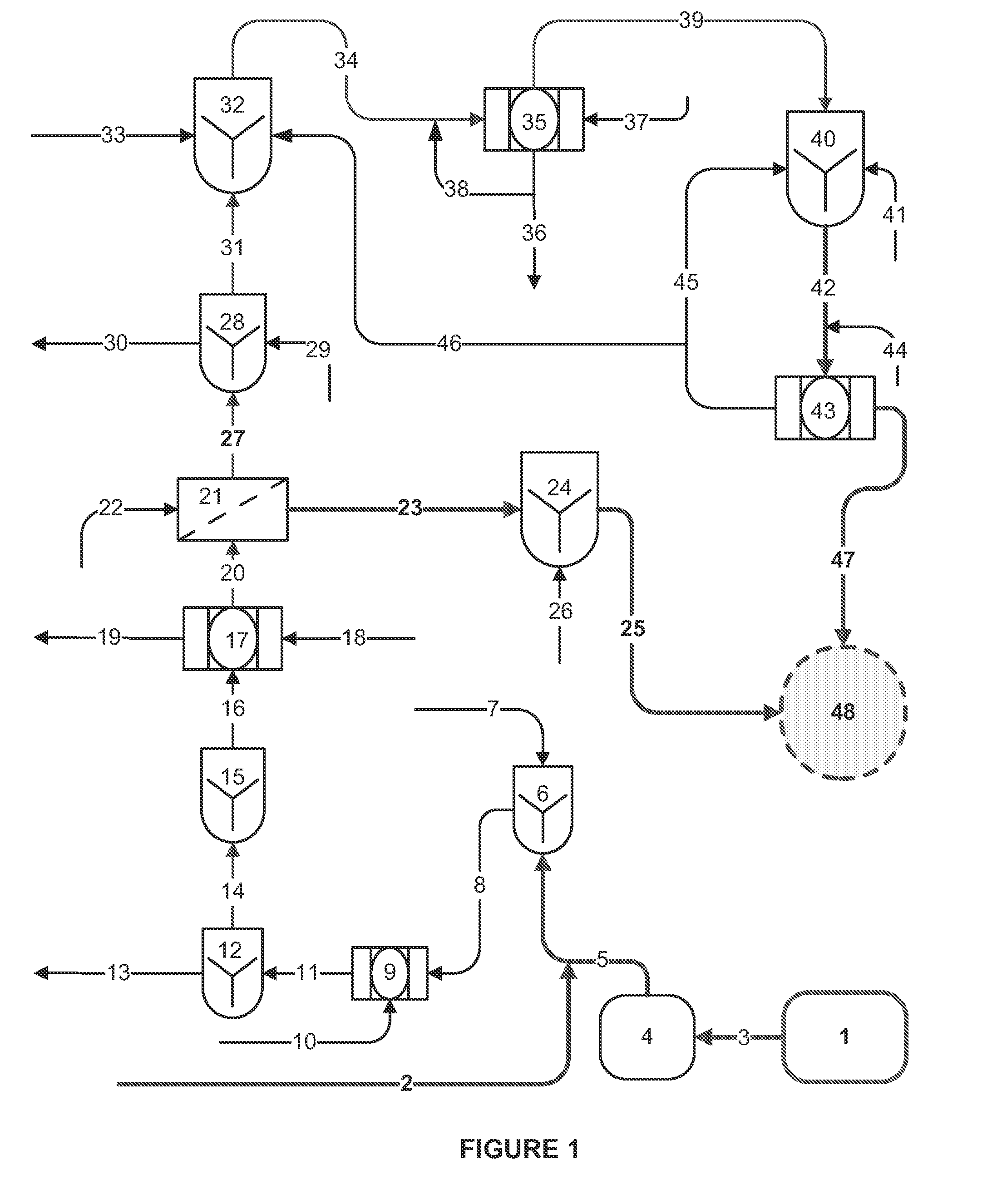Method for treating acid mine drainage
a mine drainage and acid mine technology, applied in the direction of quary waste water treatment, multi-stage water/sewage treatment, separation process, etc., can solve the problem that the epa has not established an mcl for molybdenum, and achieve the effect of reducing the concentration of calcium sulfate and reducing the concentration of metals and soluble contaminants
- Summary
- Abstract
- Description
- Claims
- Application Information
AI Technical Summary
Benefits of technology
Problems solved by technology
Method used
Image
Examples
example 1
[0065]Streams from different sources, e.g., underground mine water / springs, collected mine ground water, flotation tail filtrate, etc. were combined for treatment into a batch composite stream “A” with concentration (in mg / L) as indicated in Table 2.
[0066]“A” was subjected to iron co-precipitation step (ICP) for a reduction of Mo level to a fraction of the pre-ICP treatment level. The treated water was analyzed for cations, anions, TDS and other constituents. The results are shown in Table 2.
[0067]A portion of “A” was subject to an Enhanced Chemical Precipitation (ECP) treatment, combining iron co-precipitation (ICP), lime / calcium aluminate precipitation (LCA), and carbonation (CBN). The treated water was analyzed for cations, anions, TDS and other constituents, as shown in Table 2. All concentrations are in mg / L unless otherwise noted.
TABLE 2Metals“A”After ICPAfter ECPpH (Standard Units)NM4.17.0Al—Aluminum [TR]17161.5Be—Beryllium0.00650.0095Ca—Calcium294320180Cd—Cadmium0.0170.017Co...
example 2
[0068]A sample of composite stream “A” from Example 1 was pretreated by ICP, followed by lime precipitation at pH 10, followed by flocculation with a pre-mixed anionic polymer to aggregate the particulates with removal of the solids through a filter press.
[0069]Clarified effluent after ICP and lime treatment (“ICP & Lime”) was subject to nano-filtration (NF), generating two streams, a membrane reject (“NF concentrate”) stream and a permeate stream. The streams were analyzed for cations, anions, TDS and other constituents, as shown in Table 3.
TABLE 3Metals“A”ICP & LimeNF ConcentrateNF PermeatepHNM10.08.1110.0Al—Aluminum [TR]172.60.240.28Ca—Calcium2944306503.6Cd—Cadmium0.0170.000160.00025Co—Cobalt0.10.00240.0056Cu—Copper0.0230.0030.0028Fe—Iron0.16K—Potassium192011011Mg—Magnesium81913400.76Mn—Manganese1412200.051Mo—Molybdenum [TR]1.80.0190.019Na—Sodium363912011Ni—Nickel0.230.0110.019Pb—Lead0.000490.00034Se—Selenium [TR]0.0050.0092Si—Silicon7.72.29.10.58Zn—Zinc2.30.0140.0160.0046TSS2346...
example 3
[0070]The NF concentrate (brine) or reject stream of Example 2 was supersaturated with CaSO4, with gypsum solids in the process of precipitating out of solution as the phosphonate based antiscalant lost its effect. The stream was further treated with the separation and removal of gypsum solids by anionic polymer addition and pre-settling. Following pre-settling, the concentrate was treated by LCA followed by CBN step, at a lime dose rate of approximately 2 g / L to reach a pH of 12.7 and a Ca—Al dose rate of 3.5g / L. The Ca—Al dosage was based on 1.1:1 mass ratio of Ca—Al: [SO42−+F]. A non-ionic polymer (Amerfloc 30 flocculent) was added at a concentration of 30 ppm to assist in solids settling post LCA step, for an observed settling rate of 1.5 to 1.7 gpm / ft2. The polymer produced a thickened underflow stream containing up to 6 weight percent solids. The treated brine, following carbonation, met all test levels including selenium reduction by about 50% with the ECP process. The stream...
PUM
| Property | Measurement | Unit |
|---|---|---|
| concentration | aaaaa | aaaaa |
| specific gravity | aaaaa | aaaaa |
| retention time | aaaaa | aaaaa |
Abstract
Description
Claims
Application Information
 Login to View More
Login to View More - R&D
- Intellectual Property
- Life Sciences
- Materials
- Tech Scout
- Unparalleled Data Quality
- Higher Quality Content
- 60% Fewer Hallucinations
Browse by: Latest US Patents, China's latest patents, Technical Efficacy Thesaurus, Application Domain, Technology Topic, Popular Technical Reports.
© 2025 PatSnap. All rights reserved.Legal|Privacy policy|Modern Slavery Act Transparency Statement|Sitemap|About US| Contact US: help@patsnap.com


